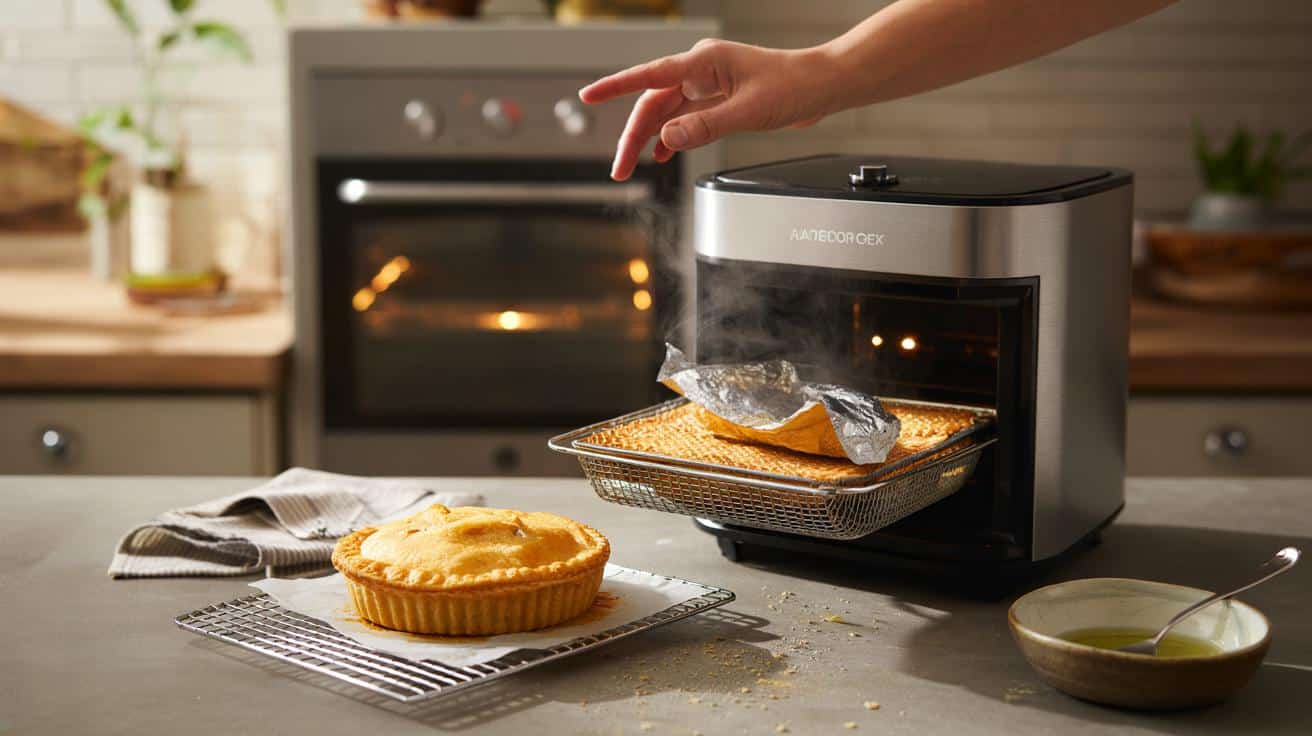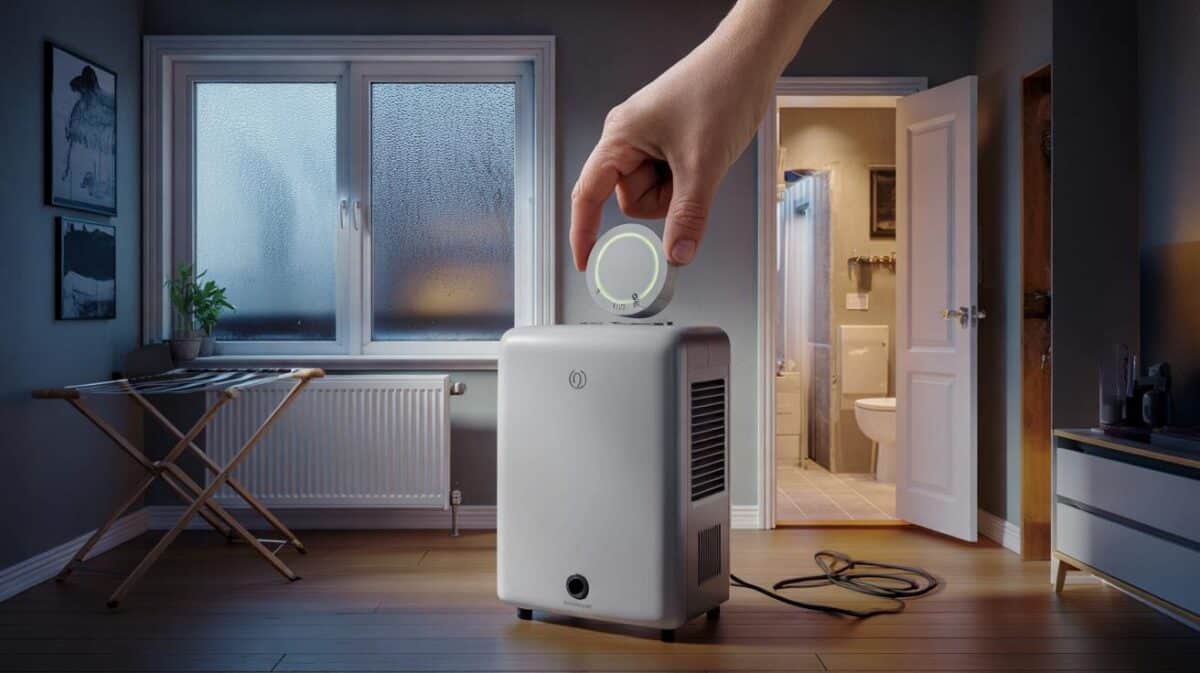A cold slice of pie and a handful of roasties deserve better than a rubbery reheat. The trick is getting them hot and crisp while sipping less energy from the meter. Here’s how to bring them back to life, without splurging on a full oven session.
Steam fogged the microwave door, the pastry sank, and the roasties turned glum before my eyes. Then the air fryer hummed for six tidy minutes, and everything changed: golden edges, flaky top, the kind of crunch you feel in your molars. The kitchen smelled like Sunday again.
We’ve all had that moment when leftovers whisper, not sing. The fix is strangely simple.
Why yesterday’s pie tastes tired
Leftover pastry slumps because fridge-cold fat hardens and starches seize. Once you blast it in a wet box, the moisture trapped between layers floods the crust and kills the crisp. Roasties suffer a similar fate: their shells soften as steam soaks back in, and the once-dry surface grows rubbery.
There’s also a heat problem. Microwaves warm the inside fast but leave the outside sticky and pale. Ovens brown beautifully yet take ages and a lot of electricity to get there. Somewhere in between lives the sweet spot for both flavour and your bills.
What brings food back isn’t just “hotter.” It’s heat plus airflow and a touch of dryness. Starch wants a gentle wake-up to relax, then a blast to re-crisp. Give pastry and potatoes a short, dry wind tunnel and they perk up. Skip the wind, and you’re just steaming yesterday.
The best low‑energy ways to revive pies and roasties
For individual pies and a tray of roasties, a compact, fan-driven heat source wins. Think air fryer or small toaster oven. Set 160°C for pies, 170°C for roasties. Pie goes in cold on a rack, 6–8 minutes, foil loosely tented if the top is deep brown. Roasties get 5–7 minutes in a single layer; shake once. Aim for “piping hot throughout,” about 75°C in the centre, then a one‑minute rest so steam settles and the crust stops hissing.
If all you’ve got is a microwave, use it as a warm-up, not a finish. Pie: 60–90 seconds at 50% power to warm the core, then straight into a hot dry pan or the air fryer for 2–3 minutes to crisp. Roasties: 30 seconds to take the chill off, then back to a dry heat tool. Let’s be honest: no one does that every day. But this two-step saves energy and rescues texture when you’re rushing between calls.
There’s a neat trick with standard ovens too. Start “cold”: put the pie in first, set to 160°C fan, and let it climb for 12–15 minutes. You skip the waste of an empty preheat, and the slow ramp coaxes the middle warm before the crust re-seals.
“Heat loves surfaces. Give it dry air and a bit of patience, and yesterday stops tasting like yesterday,” a London baker told me as she slid a tray of pork pies into a humming fan oven.
- Quick win: warm in microwave, finish in air fryer or hot pan.
- Small cavity beats big oven for one or two portions.
- Loosely tent dark pastry with foil so it doesn’t scorch while the middle wakes up.
- Single layer for roasties; crowding equals steam and soft edges.
- A teaspoon of neutral oil tossed with roasties before the finish can revive shine and snap.
Leftovers, but better
The energy maths backs this up. A big oven often draws 2–3 kW. Ten minutes to preheat and ten to reheat can be around 0.6–1.0 kWh, which on recent UK tariffs (roughly 22–30p per kWh) lands in the 13–30p zone for a single portion. An air fryer or toaster oven typically runs 1.2–1.7 kW; eight crisping minutes use roughly 0.16–0.23 kWh, or 4–7p. That’s the same crunch for a fraction of the spend. Multiply that by a winter’s worth of lunches and you feel it in your wallet as much as your fingertips.
Texture-wise, you’re playing with time and water. Warm the core gently so fats loosen and starches relax, then hit the surface with fast, dry air to drive off a whisper of moisture. Pastry comes back flaky, roasties get that sandpapery crust, and the kitchen smells like you cooked again. If you fold in what you’re already using — the small oven you preheat for toast, the pan you used for eggs — you’re not just reheating. You’re editing heat so it works for you.
Small notes matter. Keep pastry on a rack so air can swirl under. Flip roasties once and stop fiddling. Resist covering pies too tightly or you’ll trap steam and undo the crisp. And if you ever reheat a whole family pie, the cold-oven climb buys the middle time while the top stays golden. The result isn’t perfect. It’s better than perfect: it’s fresh enough to make you smile at leftovers.
Takeaways you’ll actually use
Reheating pies and roasties isn’t a chore; it’s a tiny piece of kitchen choreography. Warm the middle gently, dry the outside quickly, keep the air moving, and stop when your nose tells you it’s right. A small appliance handles one or two portions with less energy and more control, while a cold‑start oven rescues a whole pie without the waste of an empty preheat. If you’re stuck with a microwave, treat it as a stepping stone, not the destination, then finish in dry heat. One last bit of “parler vrai”: reheating once is the sweet spot — chill leftovers promptly, reheat until steaming, and call it done. When you hit that balance, yesterday’s lunch stops being a compromise. It becomes a small win you can repeat all winter long.
| Point clé | Détail | Intérêt pour le lecteur |
|---|---|---|
| Use dry, moving heat to finish | Air fryer or small toaster oven at 160–170°C for 5–8 minutes | Crisp pastry and roasties without a heavy energy bill |
| Two-step if you must microwave | Short, gentle microwave to warm the core, then crisp in dry heat | Salvages texture with tools you already own |
| Cold‑start oven for whole pies | Pie in from cold, set 160°C fan, 12–15 minutes with loose foil if needed | Skips wasteful preheating and keeps the top from over-browning |
FAQ :
- Can I reheat a pie in the microwave only?Yes, but the pastry will go soft. Use a short microwave burst to heat the centre, then crisp in a hot pan, air fryer, or toaster oven for a better bite.
- What temperature should leftovers reach?Go for “piping hot throughout,” about 75°C in the middle. If you don’t have a probe, wait for steady steam and a hot base when you touch the tray.
- How do I keep roast potatoes crunchy?Single layer, hot dry air, and a quick shake halfway. A teaspoon of oil before the finish helps revive the crust.
- Is a big oven ever worth it?For one portion, not really. For a full tray or a large family pie, a cold‑start approach balances texture and energy better than preheating an empty oven.
- Can I reheat pies and roasties more than once?Best not. Chill leftovers promptly, reheat once until steaming, and eat straight away for safety and flavour.








